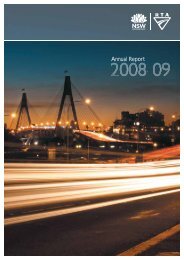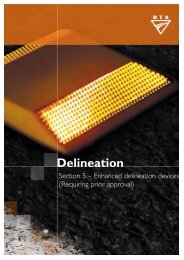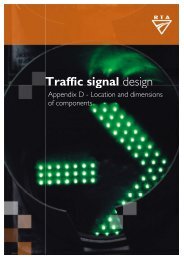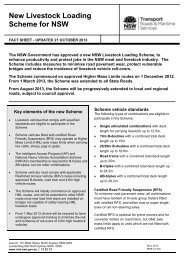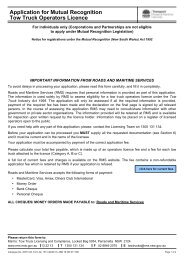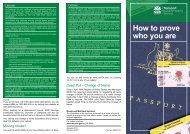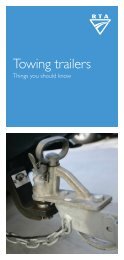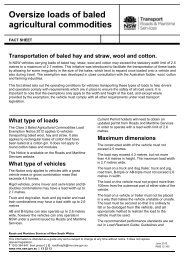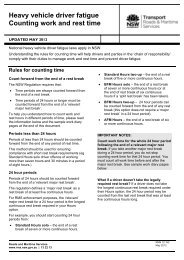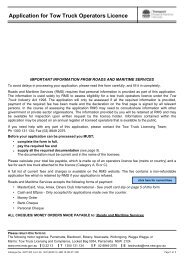Traffic Signal Design - Section 11 Detectors - RTA
Traffic Signal Design - Section 11 Detectors - RTA
Traffic Signal Design - Section 11 Detectors - RTA
Create successful ePaper yourself
Turn your PDF publications into a flip-book with our unique Google optimized e-Paper software.
<strong>Traffic</strong> <strong>Signal</strong> <strong>Design</strong> – <strong>Section</strong> <strong>11</strong> <strong>Detectors</strong><br />
decision to not install detectors should be made by the officer responsible for the SCATS<br />
operation. If there is any doubt the Manager Network Operations, Transport Management<br />
Centre, should be consulted. If it is decided not to install detectors, the controller personality<br />
must be designed to terminate the coordinated route on a maximum only (i.e. no gap or waste<br />
termination) similar to a pedestrian-actuated site. This is necessary in case the controller ever<br />
runs isolated in fallback mode.<br />
<strong>11</strong>.3.4.3 Queue<br />
Queue detectors are used in special circumstances to detect stationary traffic for queue<br />
detection and strategic purposes and must therefore operate in presence mode. The<br />
dimensions of queue detectors are the same as a standard 4.5 m long stop-line detector.<br />
Typical applications include detection of:<br />
• traffic blocking the middle of a major intersection<br />
• full or overflowing right-turn bays<br />
• queues on freeway offload ramps that are likely to overflow onto the freeway itself<br />
• queues on or near a railway level crossing adjacent to a signalised intersection<br />
<strong>11</strong>.3.4.4 Advance<br />
Advance detectors are so named because they are located in advance of the stop-line. They<br />
are only used to detect moving vehicles and are therefore operated in passage mode.<br />
Advance detectors should only be considered at sites where the approach speed is high and<br />
particularly if there is a large proportion of heavy vehicles. Where possible, they should be<br />
located to suit the stopping distance required for the 85th percentile approach speed and may<br />
be used in addition to the normal stop-line detectors.<br />
<strong>11</strong>.3.4.5 Violation<br />
Violation detectors are not to be installed at new sites, however, where they currently exist<br />
the following criteria explains the installation process and operation features.<br />
Violation detectors are installed in conjunction with a red signal violation camera and flash unit<br />
to enable red signal traffic violations to be detected. If a vehicle passes over one of the<br />
detectors while facing a red signal, the camera and flash unit are activated.<br />
The camera equipment can only accept a single red input. This normally comes from the full<br />
red, hence violation detectors should only be installed in lanes where all traffic is stopped by<br />
the full red. This includes exclusive through lanes and shared lanes where there is no left- or<br />
right-turn green arrow displayed in conjunction with the full red. Alternatively, selected<br />
detector inputs can be used for vehicles controlled by a specific red signal, but it cannot be<br />
used with left turn on red.<br />
The location and dimensions of violation detectors are shown on drawing No. VC005-30. As<br />
they are located 0.2 m past the stop-line and parallel to it, they cannot be used where an <strong>11</strong>m<br />
stop-line detector is installed. Installation details are shown on drawing No. VD002-38. Note<br />
that if the stop-line is located on an angle, then the shape of the detector is a parallelogram<br />
because of the fact that it must be parallel to the stop-line. This is the only type of detector<br />
where this is permitted. In order to avoid false actuations, no part of the loop should be any<br />
closer than 1.2 m to the trajectory of cross or turning traffic of another phase.<br />
<strong>11</strong>-4 Version 1.3<br />
UNCONTROLLED WHEN PRINTED



